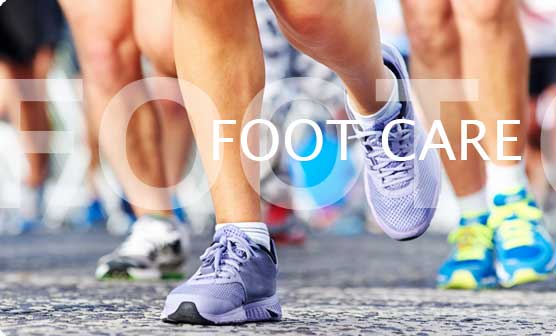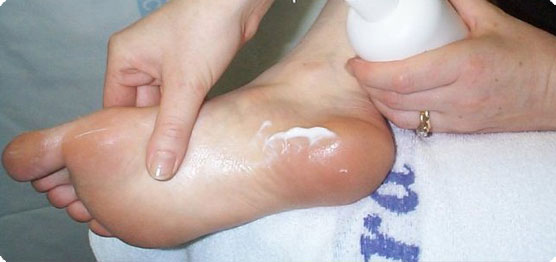Foot care

‘Diabetic foot’ is the most disastrous complication arising out of this disease. This condition can accelerate into wounds that do not heal; requiring the patient to be laid up in bed, when even the simple task of walking is painful. The condition could worsen to a state which requires hospitalisation, and expensive care. Diabetes is seen to be the major reason for amputation of the legs.
Foot related complications
Peculiar foot structure
ulcers
germ-infection, fungus
ingrown toenail
cracked heel
dry skin
calluses
Major Foot Diseases
Neuropathy
Neuropathy affects almost 75% of diabetics in different ways. This occurs when the veins in the legs are affected. The patient loses the sense of feel / sensation and does not realise the wounds in the legs. If when exposed to germs, the condition worsens and the healing delays. This may eventually lead to amputation.
Tests:
Mono filament test – to know the sensation
Pinprick test
Vibration test – to know the vibration sensation (biothesiometer)
Peripheral Vascular Disease
This happens because of the narrowing of the blood vessels through which blood reaches the legs. Walking for a long distances ensures pain below the knee which is the first symptom. Gradually the patient finds it tough to walk without pain for any short distance too. Eventually pain occurs even when sitting down.
Vascular Doppler test is used o check whether PVD is present.
What You Need to Do
Inspect your foot daily. Use a mirror to view the sole of your feet
All wounds: cuts, abrasions, tear, discolouration of the skin, swelling, puss, blisters, clots, fungus, and calluses should not be self-treated. Do approach a doctor
Choose footwear that fit your feet. Be sure that there are no stone pieces or other objects inside your shoe as that would lead to wounds
Wash your feet daily. Rinse the soap off; keep your feet clean. Wipe your feet dry using a soft cloth
Trim your toenails. When doing your nails take care to avoid nicking your fingers
Choose socks which fit well and are soft. Change your socks daily. It is advisable to have cotton socks which absorb moisture well
While lying down, or sleeping, do keep your feet elevated
Walk at least for 20 minutes daily; as it helps the blood circulation of the body

What You Should Not Do
Do not walk without slippers at home or outdoors. Do not wear wet slippers
Do not rub your feet unnecessarily
Do not scrub your feet too hard, or use pumice stone
Do not attempt to remove the calluses on your feet with a blade; as that will cause infection
Give up smoking. Smoking promotes the narrowing of the blood vessels in the legs; and leads to low blood flow to those areas.
Avoid using steam to lessen the numbness in your feet. With the loss of sensation in the feet you will not be able to realise if your skin is burned
Remember not to immerse your feet in very hot water or in very cold water
Do not use oil or any cream between the toes
Try not to keep the feet still in one position for long
Avoid using scissors, blades to cut your nails. Stick to nail cutters
Special footwear
The right footwear is very important for diabetics. Diabetics require special footwear. Designed according to the presence of wounds, scabs, calluses and other foot deformities. There is a 50% chance that such footwear will reduce foot diseases occurring due to diabetes. Do not wear footwear that is too loose or too flat.
